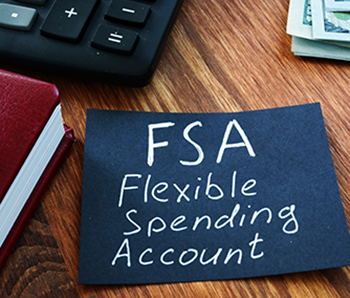
During this pandemic year, many employees have relied on flexible spending accounts (FSAs) to pay for health care and dependent care costs. This includes expenses related to COVID-19. Employers that offer employees FSAs also reap several benefits. But if you offer employees FSAs, it’s important for both employers and employees to keep abreast of the latest changes, including those that may affect important decisions before the end of 2020.
2 Primary Tax Breaks
Because FSAs are funded with employees’ pre-tax contributions, plan participants can reduce their income and payroll tax liabilities. For example, an employee in the 24% tax bracket who contributes $5,000 to an FSA and uses the money to pay for qualified expenses saves $1,200 (24% of $5,000) in Federal income tax, plus up to $382.50 in Federal payroll tax (7.65% of $5,000). These savings total $1,582.50.
Similarly, employers aren’t responsible for payroll taxes due on the amounts contributed by employees to FSAs. If a company has ten employees in the same situation as described above, the employer can save as much as $3,825 (10 x $ 382.50) a year. FSAs also benefit employers by helping them recruit and retain good workers.
2 Types
Your company may offer one or both of the two types of FSAs.
- Health care FSAs. Participants arrange to have an amount deducted from their paychecks and deposited in their personal accounts. The money is then used throughout the year to pay for qualified health care expenses as needs arise. An FSA covers expenses for an employee and the employee’s spouse and dependents age 26 or younger.
The annual contribution limit for health care FSAs is $2,500, indexed for inflation. For 2020, the limit is $2,750. (The 2021 limit will be announced shortly.) Qualified expenses (which generally mirror medical expenses deductible on federal tax returns) include:
- Co-payments, co-insurance and deductibles,
- Dental and vision care,
- Prescription drugs and insulin,
- Pregnancy tests and breast pumps,
- Bandages, crutches and wheelchairs,
- Acupuncture,
- Chiropractic treatment,
- Mental health treatment, and
- Physician-approved smoking-cessation programs.
FSAs can’t be used to cover health insurance premiums. And, as with medical deductions, qualified expenses don’t include payments for certain expenses such as gym memberships.
Generally, health FSAs can’t be used to buy over-the-counter medicines or products. But to help ensure individuals are able to use all health FSA funds in 2020, the CARES Act is allowing participants to buy certain over-the-counter drugs such as pain relievers and allergy medicines as well as feminine hygiene products.
- Dependent care FSAs. Funds in these accounts may cover expenses of caring for a child under age 13 or a dependent who is physically or mentally incapable of self-care (for example, an elderly family member with Alzheimer’s Disease).
The annual limit for contributions is $5,000 (and this figure isn’t indexed for inflation). Unlike health care expenses — which normally aren’t easily predictable — plan participants often have a better idea of their yearly dependent care expenses. Nevertheless, in 2020, the pandemic has changed a lot of what’s considered “normal.” Dependent care expenses generally are qualified if they enable plan participants and their spouses (if married) to work. These include payments made to or for:
- Day care or adult care facilities.
- Babysitters, nannies and nursery schools,
- Summer day camp,
- Before- and after-school programs, and
- Housekeepers who also provide childcare.
Participants can’t use their dependent care FSA to pay for food, clothing and entertainment; child support; educational supplies; overnight camp; or cooking and cleaning services not provided by a caregiver. Although FSAs generally can’t be used to pay your older children to watch your younger kids, it could be allowed in certain limited situations.
Year End Considerations
In the past, employees were generally required to exhaust all of their health care FSA funds by the end of the plan year. Otherwise, they forfeited the remaining amount under the “use-it-or-lose-it” rule. However, employers can amend their written plans to adopt a grace period, which gives employees extra time to use up remaining funds. And for 2020, the IRS is allowing employers to offer employees one of a couple options.
In the first, an employer may provide heath FSA plan participants with a grace period of up to 2 1/2 months and the employer is given a longer period to amend its written plan. Under this relief, that would mean employees participating in a calendar-year plan would be allowed to use the balance in their accounts at the end of 2020 as late as March 15, 2021. As the second option, an employer could allow participants to carry over up to $550 of unused funds to 2021. Any excess over that amount would be forfeited. It’s important to note that employers can allow employees to benefit from either the grace period or the carryover rule, but not both.
Employees with FSAs may also need to make some decisions. For example, they may want to take the pandemic into account when estimating 2021 health care and dependent care expenses. While you’ll want to maximize the tax benefit, keep in mind that you could lose the funds that have been set aside. Thus, be careful not to overestimate your expenses — unless you are confident that the carryover provision will enable you to use any amount that remains as of the end of the year.
Keeping Options Open
To ensure your company’s FSA complies with IRS rules and that you offer employees all available options, consult with your employee benefit and financial advisors. Let employees know that they may want to discuss their FSA allocations with their personal financial advisors.
© 2020




